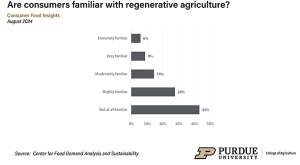Most consumers are unfamiliar or only slightly familiar with regenerative agriculture

Published: October 11, 2024
Category: Regenerative Agriculture
By Steve Koppes
Many members of the public lack familiarity with the farming methods known as regenerative agriculture, according to Purdue University’s August 2024 Consumer Food Insights Report (CFI).
The survey-based report out of Purdue University’s Center for Food Demand Analysis and Sustainability (CFDAS) assesses food spending, consumer satisfaction and values, support of agricultural and food policies, and trust in information sources. Purdue experts conducted and evaluated the survey, which included 1,200 consumers across the U.S.
Regenerative agriculture refers to farming methods that result in improved soil health, carbon capture, improved biodiversity and healthy water resources. Around 43% of survey respondents said they were “not at all familiar” with the term “regenerative agriculture,” and another 28% are only “slightly familiar.”
“This reveals an opportunity for producers and industry leaders interested in expanding regenerative agriculture practices in their operations to clearly communicate to consumers what regenerative agriculture means to their operations,” said the report’s lead author, Joseph Balagtas, professor of agricultural economics at Purdue and CFDAS director.

“How familiar are you with the term ‘regenerative agriculture'”?, Aug. 2024
Brenna Ellison, professor of agribusiness management at Purdue, recently blogged about this lack of understanding among consumers and the importance of clear communication if regenerative agriculture is going to be more than a buzz phrase.
After presenting respondents with the broad definition of regenerative agriculture, CFDAS researchers gauged support for or opposition to the practice in the context of four hypothetical scenarios. The first two scenarios involved practicing regenerative agriculture on U.S. farms and the voluntary adoption of its methods by farmers. The other two scenarios related to industry or government plans that provide financial incentives for adopting the practices but that would result in higher prices or taxes to pay for the incentives.
“While consumers say they generally support regenerative agriculture initiatives, the level of support goes down when given additional information about the cost,” Balagtas said. An education policy study published in 2018 revealed a similar result in the context of spending on education.
“Understandably, food policy is likely to be less popular when it comes at the expense of consumers, who are already dealing with high food prices,” Balagtas said.
Affordability other attributes that consumers see as benefits of regenerative agriculture, such as improving soil health or reducing water use. “The benefits of regenerative agricultural practices come at a cost, part of which may be borne by food consumers or taxpayers. Advocates of regenerative ag will need to consider the willingness of consumers or taxpayers to pay for those practices,” Balagtas said.
Source: Purdue University
To view source article, visit:
Organic & Non-GMO Insights October 2024








